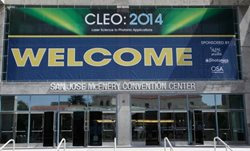
With 5,000 attendees and more than 2,600 paper submissions, this year’s CLEO featured a lot of high-impact research as well as notable speakers and special events. Here are a few highlights from the meeting:
High-Impact Research
Broadband on the Moon
A joint team from MIT’s Lincoln Laboratory, U.S.A., and NASA presented the implementation details for the on-orbit performance of their record-shattering Lunar Laser Communication Demonstration (LLCD), a laser-based communication uplink between the moon and Earth, which beat the previous record transmission speed last fall by a factor of 4,800.
Using Lasers and Night Vision for Cancer Treatment
Lymphedema, the collection of lymph fluid in the extremities that causes painful swelling, can be a side effect of cancer treatment. If doctors detect lymphedema early, people with cancer could experience better treatment outcomes. Early diagnosis is difficult because of the lack of high-res imaging methods that can “see” small lymph vessels. Researchers from the University of Texas Health Science Center at Houston Medical School, U.S.A., are using a device they’ve named “NIRFLI” (near-IR fluorescence laser imaging) that incorporates lasers and night-vision technology to image the lymphatic system and calculate changes in fluid volume.
OCT Improves Epidurals and Blood Monitoring
Optical coherence technology (OCT) is commonly used in eye imaging, but its proving useful in other areas of medicine. Researchers from the University of Maryland, U.S.A., integrated OCT into an epidural needle. The OCT helps anesthesiologists guide the needle around blood vessels and other anatomical road blocks to provide spinal anesthetic with greater accuracy and with less pain. A team from the University of California, Davis, U.S.A., is using OCT in a new way to measure oxygen saturation, red blood cell flow rates and to image the inside of blood vessels.
Terahertz Waves Measure Paint Thickness
A quality paint job, on your car or in your house, is characterized by uniformly applied coats. Anis Rahman, founder of Applied Research and Photonics, Inc., U.S.A., developed a method for non-invasively assessing the quality of paint application using a terahertz beam to penetrate and measure paint layers. The beam goes through the paint layers and bounces back at different intensities of light depending on the thickness of each layer. This method can also be used to estimate the size of particles added to the paint as small as 25 nm.
Laser Sensing for Self-Driving Cars, Smartphones and Video Games
A laser sensing system, developed by researchers at the University of California, Berkeley, U.S.A., can remotely sense objects across distances 30 feet long, which is 10 times farther than what could be done with comparable low-power laser systems. The technology could be used to make smaller, cheaper 3-D imaging systems for self-driving cars, smartphones and interactive 3-D video games.
Special Events
Symposium in Memory of James P. Gordon
James Gordon, one of the founding fathers of quantum electronics, was remembered during a special symposium. Three Nobel Laureates and other well-known laser experts discussed their personal connections to Gordon and his influence on their work.
NPI Webinar
The National Photonics Initiative (NPI) hosted a webinar to provide information on the U.S. Department of Defense’s recent Request for Information (RFI) for a possible photonics Institute for Manufacturing Innovation under the Obama administration’s National Network for Manufacturing Innovation. The webinar gave attendees an overview of the RFI process and provided information on how NPI can be a resource.
